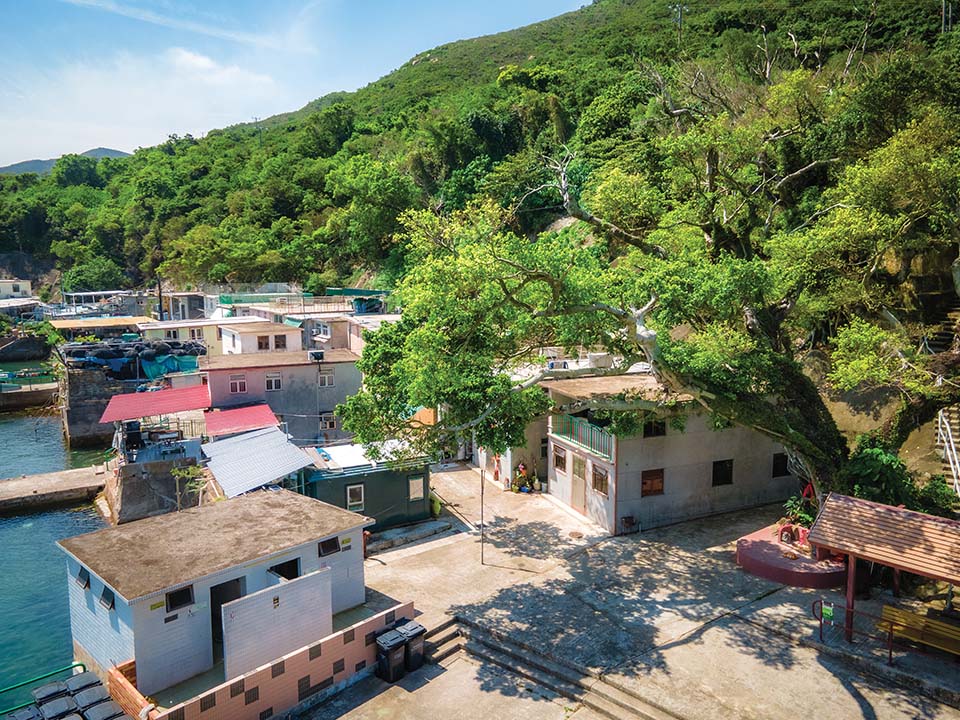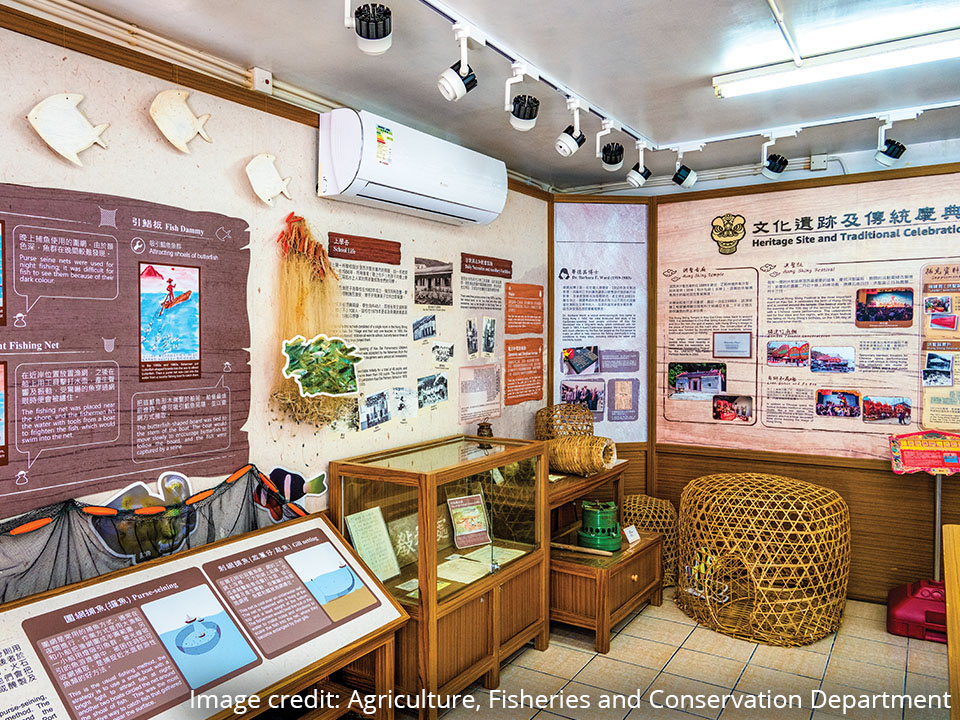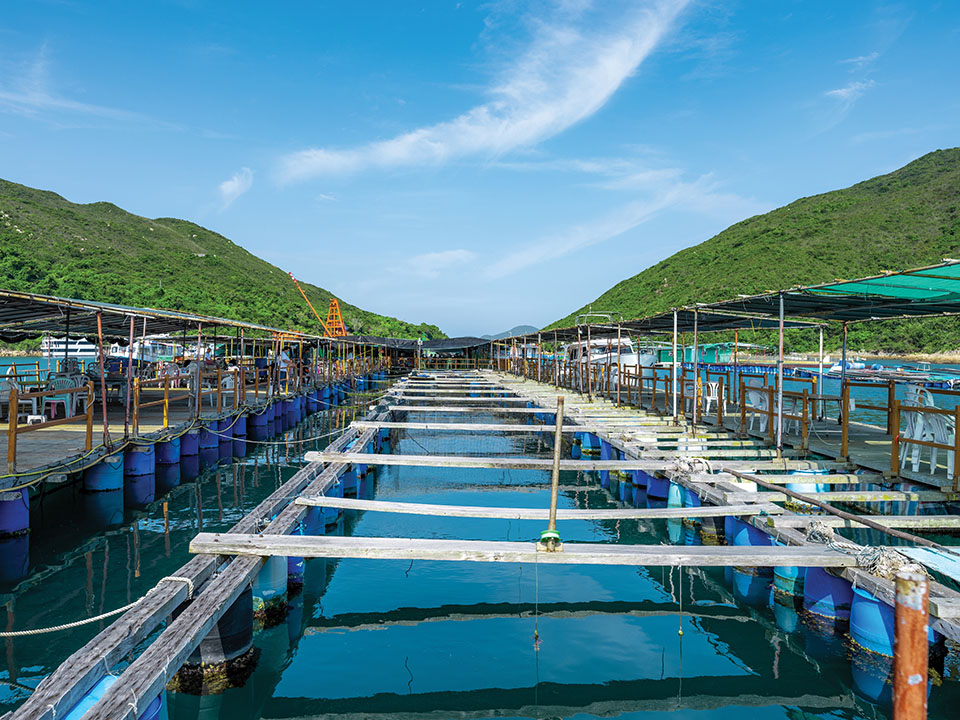
Written by South China Morning Post (Morning Studio)

Artsy Voyage at Sai Kung Hoi
Visit Sai Kung Hoi Arts Festival 2023 for a unique art and nature experience with artworks co-created by artists and villagers on the tranquil islands of Sai Kung.
Most people heading to the figure-of-eight-shaped Kau Sai Chau — the largest island off the Sai Kung Peninsula and considered a Hong Kong UNESCO Global Geopark geosite — visit only the top half to play golf at Hong Kong’s sole public golf course. Yet on its southernmost tip, out of sight over gently rolling hills, is a rarely seen fishing hamlet, Kau Sai Fishermen Village — the island’s only settlement, which seems little changed over time. Hire a sampan to this picturesque village, home to barely a dozen families and a historic temple, separated by a narrow strait from Jin Island. These waters shelter floating fish farm rafts where you can enjoy recreational fishing activities and unwind by the sea.

Refuel
The village store and also the last-but-one house as you turn left from Kau Sai Fishermen Village Pier, sells drinks from an outdoor fridge and offers a selection of ‘fishing village dishes’ chalked up on a blackboard.
-
Kau Sai Fishermen Village
A 40-minute sampan trip, passing enticing beaches and caves, brings you to the village and its single row of seafront two-storey houses. Living rooms open directly onto the pathway, and you can see families sitting outside preparing and eating lunch. An elderly fisherman wearing a traditional rattan hat sits cleaning lobster cages, as fishing and diving equipment hang drying in the breeze. It’s hard to imagine now, but more than 300 people lived here in the 1950s, many of them on boats — according to tradition — anchored in the bay. A memorial plaque pays tribute to British social anthropologist Barbara Ward, who lived here while studying the fishing community’s culture. She helped the fishermen get government permission to set up homes on the land in the 1950s, which led to the founding of Kau Sai Fishermen Village. Over the decades since then, most residents have moved to the city or overseas.
 Just in case the village store is closed, bring enough drinking water for your time on the island, plus sun protection, including a hat and sunscreen. Remember to follow guidelines for visiting the Geopark: do not wander off the recommended sightseeing routes, don’t hike near cliffs to avoid injuries from falling rocks, and respect the geopark communities and their heritage. Visit the official website to learn more.
Get me there
Just in case the village store is closed, bring enough drinking water for your time on the island, plus sun protection, including a hat and sunscreen. Remember to follow guidelines for visiting the Geopark: do not wander off the recommended sightseeing routes, don’t hike near cliffs to avoid injuries from falling rocks, and respect the geopark communities and their heritage. Visit the official website to learn more.
Get me there
-
Hung Shing Temple
The village’s elaborately decorated temple was built more than 130 years ago to honour Hung Shing, a deity believed to protect fishermen and sea traders, who is also known as the Chinese ‘God of the South Sea’. Official records give no exact date, but say it was first renovated in 1889. The grey brick building, with images of two dragons running along the roof and a line of brightly coloured pictorial tiles on the front wall, once included a classroom for villagers’ children. Later restoration of the temple, now a declared monument, saw its heritage conservation recognised in 2000 by UNESCO. The large space in front of the temple is used to stage the four-day-long birthday celebrations for Hung Shing — attended by thousands of people — featuring lion and dragon dancing and a Chinese opera performance during the second lunar month each year.
Get me there
-
Kau Sai Village Story Room
Next door to the temple, the ground floor of the village office has been turned into an exhibition space, to display historic fishing implements, other cultural relics and old photographs of Kau Sai Village, as well as a range of local herbs used in Hakka culture for traditional medicine. The story room, run by villagers with the support of the Lions Nature Education Foundation and Hong Kong Geopark, is open from 10am to 4pm on Sundays and public holidays (but close in the first month of lunar year).
Get me there
-
Scallop Rock
Walk past the story room to the viewing pavilion to see Scallop Rock — which looks like a scallop you would find on your dinner plate — only two metres wide. This rock fragment, eroded by waves over centuries, broke off one of the many hexagonal rock columns found in Sai Kung Volcanic Rock Region, in Hong Kong UNESCO Global Geopark. The columns, created as dense volcanic ash and lava cooled following eruptions 140 million years ago, are estimated to cover an area of more than 100 sq km.
The pavilion also offers a view across the narrow gap known as Kau Sai Strait towards uninhabited Jin Island, also called Tiu Chung Chau — Chinese for ‘hanging bell island’ — because of the spectacular bell-shaped sea arch at its southern end. Hikers visit the island, covered with impressive fragmented hexagonal rock formations, for the stunning scenery, but to get there must hire a sampan or join a recommended Geopark guided tour.Get me there
-
Herbal Plant Trail
Find the green sign near the temple and climb the steps, past the shaded clearing where the village school used to stand, and you’re on a hill trail lined by some of the flowering plants used by villagers for traditional herbal medicine, such as tea or medicinal soup. You can pick up a herbal trail leaflet in the story room, which will help you to identify some of the plants. As you rise higher, you leave the forest behind, and the path offers stunning open views of the islands, bays and rocky shores of Port Shelter.
Get me there
-
Kau Sai Fish Culture Zone
In the sheltered bay between the two islands, Kau Sai Chau and Jin Island, you will find one of the largest marine fish culture zones in Hong Kong, where marine fish species including star snapper, Russell’s snapper and giant grouper are raised in cages suspended by floating rafts. You can learn how fish are raised and caught, and practise your fishing skills in the fishing area, and children can play in the children’s net fish area. You’re beside and above the water, so you can spend the afternoon with your family there, while enjoying the sea breeze and the gentle lapping of waves. Book ahead of your visit.
Get me there
-
Dining Option
Sai Kung Town Centre
Sai Kung is known for its many waterfront seafood restaurants, which are particularly popular, serving treats such as steamed prawns with chilli soy sauce and clams with black beans and garlic. But there is also a great selection of trendy restaurants, cafes and cha chaan tengs along the promenade and lively side streets, which serve a vast range of popular and Eastern cuisines, including pizzas, pasta, Thai curries, English fish and chips and Turkish kebabs.
Get me there

Transport
Getting to Kau Sai Fishermen Village:
Take any public transport to Sai Kung Town Centre (for instance, bus 92 from MTR Diamond Hill Station or bus 299X from Sha Tin Central Bus Terminus) and walk to the waterfront. Here you'll find stalls selling sampan and speedboat tickets to various islands off Sai Kung. You'll have to negotiate a price for your journey to Kau Sai Fishermen Village, and specify when you would like your boat captain to return to pick you up. Prices will likely be higher at busy times such as holiday weekends.
Alternatively, transportation from Sai Kung to Kau Sai Fish Culture Zone and a visit to Kau Sai Fishermen Village is included in the fishing session booking; you could join the Sai Kung Volcanic Rock Region Sea Tour from the Volcano Discovery Centre next to the bus station, which calls in at Kau Sai Fishermen Village; it’s best to book ahead by calling 2394 1538. Visit the official website for more information.
Leaving from Kau Sai Fishermen Village:
Your water transport will come back to collect you at the time you arranged, but as a precaution, make sure you take note of the mobile phone number of the sampan or speedboat captain.
More Routes

Written by South China Morning Post (Morning Studio)

Artsy Voyage at Sai Kung Hoi
Visit Sai Kung Hoi Arts Festival 2023 for a unique art and nature experience with artworks co-created by artists and villagers on the tranquil islands of Sai Kung.

Most people heading to the figure-of-eight-shaped Kau Sai Chau — the largest island off the Sai Kung Peninsula and considered a Hong Kong UNESCO Global Geopark geosite — visit only the top half to play golf at Hong Kong’s sole public golf course. Yet on its southernmost tip, out of sight over gently rolling hills, is a rarely seen fishing hamlet, Kau Sai Fishermen Village — the island’s only settlement, which seems little changed over time. Hire a sampan to this picturesque village, home to barely a dozen families and a historic temple, separated by a narrow strait from Jin Island. These waters shelter floating fish farm rafts where you can enjoy recreational fishing activities and unwind by the sea.

Refuel
The village store and also the last-but-one house as you turn left from Kau Sai Fishermen Village Pier, sells drinks from an outdoor fridge and offers a selection of ‘fishing village dishes’ chalked up on a blackboard.

Transport
Getting to Kau Sai Fishermen Village:
Take any public transport to Sai Kung Town Centre (for instance, bus 92 from MTR Diamond Hill Station or bus 299X from Sha Tin Central Bus Terminus) and walk to the waterfront. Here you'll find stalls selling sampan and speedboat tickets to various islands off Sai Kung. You'll have to negotiate a price for your journey to Kau Sai Fishermen Village, and specify when you would like your boat captain to return to pick you up. Prices will likely be higher at busy times such as holiday weekends.
Alternatively, transportation from Sai Kung to Kau Sai Fish Culture Zone and a visit to Kau Sai Fishermen Village is included in the fishing session booking; you could join the Sai Kung Volcanic Rock Region Sea Tour from the Volcano Discovery Centre next to the bus station, which calls in at Kau Sai Fishermen Village; it’s best to book ahead by calling 2394 1538. Visit the official website for more information.
Leaving from Kau Sai Fishermen Village:
Your water transport will come back to collect you at the time you arranged, but as a precaution, make sure you take note of the mobile phone number of the sampan or speedboat captain.


























 Live Chat
Live Chat









